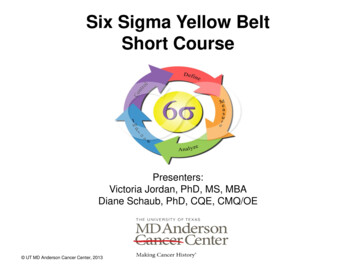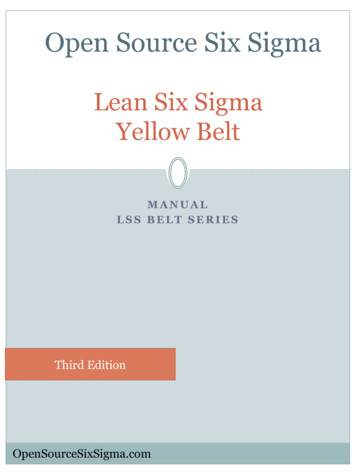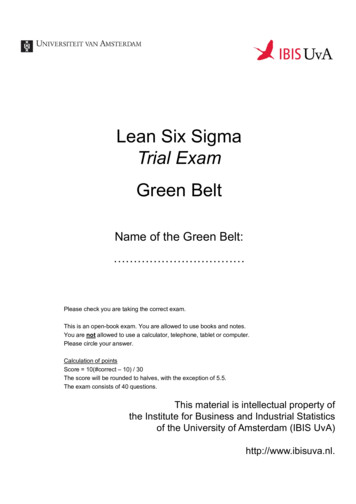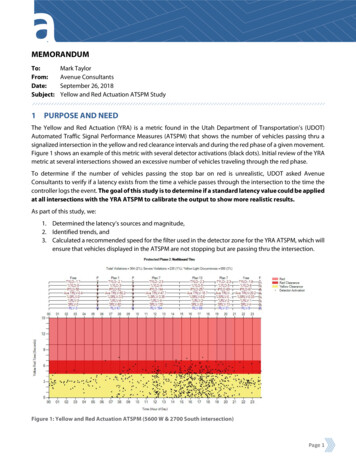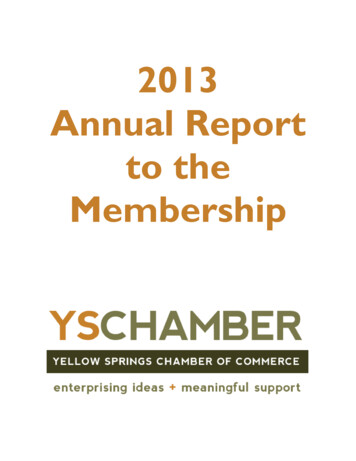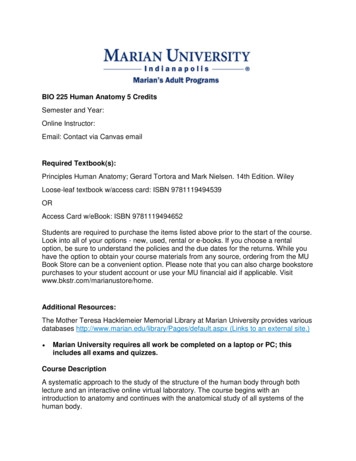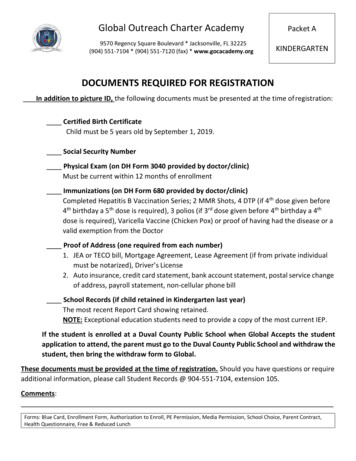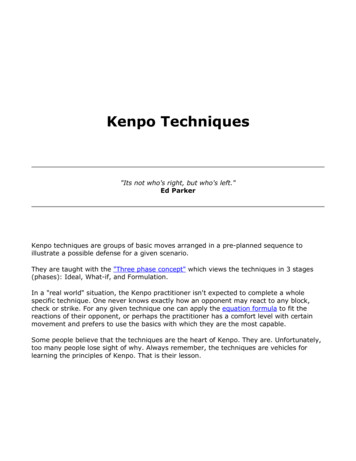
Transcription
Kenpo Techniques"Its not who's right, but who's left."Ed ParkerKenpo techniques are groups of basic moves arranged in a pre-planned sequence toillustrate a possible defense for a given scenario.They are taught with the "Three phase concept" which views the techniques in 3 stages(phases): Ideal, What-if, and Formulation.In a "real world" situation, the Kenpo practitioner isn't expected to complete a wholespecific technique. One never knows exactly how an opponent may react to any block,check or strike. For any given technique one can apply the equation formula to fit thereactions of their opponent, or perhaps the practitioner has a comfort level with certainmovement and prefers to use the basics with which they are the most capable.Some people believe that the techniques are the heart of Kenpo. They are. Unfortunately,too many people lose sight of why. Always remember, the techniques are vehicles forlearning the principles of Kenpo. That is their lesson.
Kenpo TechniquesTable of ContentsTable of ContentsConcepts . 3The Three Phase Concept. 3Equation Formula . 3Required Techniques For Yellow Belt . 1Optional Techniques. 3Required Techniques For Orange Belt . 6Optional Techniques. 10Required Techniques For Purple Belt. 14Optional Techniques. 18Required Techniques For Blue Belt . 21Optional Techniques. 26Required Techniques For Green Belt . 29Optional Techniques. 33Required Techniques For Adv Green Belt. 36Optional Techniques. 42Required Techniques For 3rd Brown Belt . 46Optional Techniques. 54Required Techniques For 2nd Brown Belt. 56Required Techniques For 1st Brown Belt. 63Optional Techniques. 71Required Techniques For 1st Black Belt . 74Optional Techniques. 82i
Kenpo TechniquesConceptsConceptsThe Three-Phase ConceptKenpo techniques are taught with a three phase formula where the student is expected tolearn the technique as written [ in stone of course :-) ], then go on to play with thepossibilities. The Three Phases are, in order, the following:Ideal PhaseIn the Ideal Phase the student learns the technique "by the book". This means the attack isspecified, the defense is applied and the attackers reaction is known.What-If PhaseIn the What-If Phase the student(s) experiment with different possible scenarios for theattack and attackers reactions.Formulation PhaseWith the Formulation Phase the student tears apart the technique, explores its principlesand develops alternate, spontaneous, reactions all with the aid the equation formula.Equation FormulaThe Equation Formula for fighting was designed as a formula to allow fighters tobuild/design logical and practical fighting techniques. It states that for any base move (iepunch/kick) or group of moves (technique - ie Delayed Sword) one may modify theirintention by:1. Alter the target area, weapon, or both.2. Prefix a strike or block with an off angle body positioning (ie step out of the way ofthe weapon!).3. Perhaps Suffix your strike with one or several more.4. Rearrange the order of a technique. Instead of block-chop-punch change it to blockpunch-chop (don’t forget to block though :-)).5. Insert a move, perhaps simultaneously, such as a check of another weapon.6. Delete a move to prevent unwanted injury to yourself, your opponent or to preventunnecessary time spent engaging and less time leaving!7. You may wish to adjust the range or angle of the weapon.8. Regulate your weapons speed or force and you may get a very different reaction.ii
Kenpo TechniquesRequired Techniques For Yellow BeltRequired Techniques For Yellow Belt1. GRIP OF DEATH (flank head lock) 1. With opponent applying lock from your left side, step forward and to your left (to 10o'clock) with your right foot (into a right close kneel) while turning your head to the left andtucking your chin against your chest. Simultaneously deliver a right hammer fist toopponent's groin and a left hammer fist to opponent's kidney.2. As you pivot into a left forward bow facing 6 o'clock, have the fingers of your left handpress under opponent's nose or, depending upon the circumstances, have your left handgrab opponent's hair to force opponent's head back.3. Immediately follow-up with a right heel of palm thrust to opponent's chin as you pivotinto a left forward bow. However, make sure that the head of your opponent in either of theabove cases is arched and forced back and down to minimize your opponent's leverage thuspreventing him from executing a right knee kick to your groin area.2. OBSCURE WING (flank left hand shoulder grab) 1. With feet together and opponent's left hand grabbing your right shoulder, step to yourright (to 4 o'clock) with your right foot as you drop into a horse. Simultaneously deliver aright back elbow to opponent's solar plexus as your left hand pins and checks opponent'sleft hand to your right shoulder.2. Deliver a right back hammer fist down to opponent's groin and follow-up with a righthand grab to opponent's testicles.3. Immediately follow-up with a right snapping obscure elbow strike to opponent's chin;making sure that your right arm follows the contour of your opponent's body.3. THRUSTING SALUTE (front straight right kick) 1. While standing naturally with feet together, step back with your right foot (to 4 o'clock)into a left neutral bow as you deliver a downward block to the inside of opponent's rightkicking leg.2. Have your left foot pivot counter clockwise, in place, as you kick forward with the ball ofyour right foot to opponent's groin. Simultaneously have your left hand check high (leftextended outward but relaxed hand sword) for possible head shots.3. As you plant your right foot forward toward 11 o'clock (between opponent's legs and intoa right neutral bow), deliver a right torquing heel of Palm thrust to opponent's jaw whileyour left hand checks near your right ribcage.4. LONE KIMONO (front left hand lapel grab) 1. Standing naturally, step back (to 6 o'clock) with your left foot when your opponentsgrabs your lapel with his left hand. Simultaneously pin his left hand to your chest with yourleft hand and deliver a right upward strike against his left elbow just above the joint thuscausing the elbow to break as you pivot into a right neutral bow.2. Then circle your right arm over and down (counter clockwise) with an nward-downwardstrike against opponent's left forearm. Make sure that your opponent's left arm is drivendown and diagonally to your left.1
Kenpo Techniques Required Techniques For Yellow Belt3. After cocking your right hand slightly toward you with your right palm up, deliver a rightoutward chop to the right side of opponent's neck; stance throughout is still a right neutralbow. Cock your left hand at your solar plexus, ready to check when needed.5. RAINING CLAW (front uppercut right punch) 1. Standing naturally with feet together, step back to 6 o clock with your left foot (into aright neutral bow) and deliver a right downward inward block to right forearm of opponent'suppercut. Your left hand is guarding high to protect your head area.2. Immediately shoot a left overhead claw to opponent's face while your right elbow staysclose to your body.3. Have your right fist circle clockwise and execute a right uppercut thrust to opponent'sface while shuffling forward with your left hand checking low.6. CROSSING TALON (front right cross wrist grab) 1. With opponent's right hand grabbing your right wrist, counter grab his wrist as your leftfoot steps forward and to your right (to 2 o'clock) into a left neutral bow simultaneouslystriking opponent's right elbow with your left forearm in a forward thrusting motion whileyour right hand pulls in toward and past your right hip.2. Continue to push and pull opponent's arm to your right forcing opponent's head downwith the possibility of your opponent's head striking your left knee.3. Immediately deliver a left side elbow strike (palm up or down depending oncircumstances) to opponent's right jaw hinge followed by a left heel palm strike and fivefinger rip to opponent's face.4. Circle your left arm clockwise and strike down with your left elbow striking to upper spineof opponent.5. Follow-up with a left downward heel palm strike to back of opponent's left mastoid. Asyour left hand continues to push down, simultaneously deliver a right knee kick toopponent's face, causing a sandwiching effect.6. Replant your right foot to original position.7. TRIGGERED SALUTE (front right hand direct push) 1. Standing naturally while opponent pushes your left shoulder with his right hand, stepforward and to your left with your right foot to 11 o'clock (into a right neutral bow) tobuckle on the inside of opponent's right knee. Simultaneously pin opponent's right handwith your left (against your left shoulder) and strike opponent's chin with a right forwardheel palm thrust.2. Immediately shift your right hand to 11 o'clock forming the shape of the crane (anchorelbow) and hook opponent's right arm down before cocking your right arm to your right hipand deliver a right inward horizontal elbow strike to opponent's solar plexus.3. After following through with first elbow shot, deliver a right outward horizontal elbowstrike to opponent's right floating ribs (palm down).4. Without hesitation, follow-up with a right horizontal back knuckle strike to opponent'sright floating ribs or kidney and immediately cock your right fist to your right hip.5. Without any loss of motion execute a right uppercut up and under opponent's chin whileyour left hand remains pinning your opponent's right hand against your left shoulder.2
Kenpo TechniquesRequired Techniques For Yellow Belt8. LOCKING HORNS (front head lock) 1. With feet in line with each other and body bent forward, step forward with your right foottoward 11 o'clock and deliver a right upward vertical reverse hand sword to opponent'sgroin while simultaneously having your left hand check opponent's right thigh just above theknee and your chin turned in such a position so as to keep your breathing constant. (Turnyour chin to the right and tuck it against your chest.)2. Immediately follow-up with a right vertical obscure elbow strike to opponent's jaw whilekeeping in a low right neutral bow.3. After snapping the elbow to opponent's jaw loop your right elbow and strike again(shuffling forward if needed) having it drive from 1 o'clock down to 7 o'clock to the left sideof opponent's jaw as your left heel of palm hooks in and strikes opponent's right jaw thuscausing a sandwiching effect.9. GIFT OF DESTRUCTION (handshake) 1. With right hand shaking and while standing naturally, hop directly forward or slightly toyour left to 11 o'clock, depending on circumstances, with our left foot as your right handpulls your opponent's right hand toward and past your right hip.2. With the above action, simultaneously strike in and against the joint of your opponent'sright elbow with your left heel of palm as you deliver a right knee kick to opponent's groinor stomach.3. As you plant your right foot forward (toward 10 o'clock) and against the inside portion ofopponent's right knee, (in a right neutral bow) deliver a right inward horizontal elbow striketo left jaw of opponent while checking opponent's right arm down with your left hand.10. THRUSTING PRONGS (front bear hug-arms pinned) 1. Step back with your right foot (to 6 o'clock) into a left modified forward bow), havingonly your right foot move back and not the upper body. Simultaneously thrust both of yourthumbs (keeping thumbs together) up and to opponent's groin.2. Strike opponent's groin with your right knee as your left hand circles over and on top ofopponent's right shoulder (forming the shape of the crane) and pins (with the assistance ofyour anchored left elbow) your opponent's right shoulder down, while cocking your righthand to your right hip.3. With knee in groin, immediately deliver a right knife-edge kick (to 2 o'clock) to the insideof opponent's left shin.4. Scrape opponent's shin with your right foot and convert the
Kenpo techniques are groups of basic moves arranged in a pre-planned sequence to illustrate a possible defense for a given scenario. They are taught with the "Three phase concept" which views the techniques in 3 stages (phases): Ideal, What-if, and Formulation. In a "real world" situation, the Kenpo practitioner isn't expected to complete a whole specific technique. One never knows exactly how .File Size: 1MBPage Count: 86Explore furtherEd Parker’s American Kenpo Curriculum – KenpoTechwww.kenpotech.netEd Parker's Original Kenpo Techniquesamericankenpo.comThe Ultimate List of Kenpo Martial Arts Techniques and .sportsaspire.comEd Parker’s American Kenpo Yellow Belt Requirements .www.kenpotech.netBrad Hunting Kenpo Karate Forms and Techniqueswww.techspin.infoRecommended to you based on what's popular Feedback
